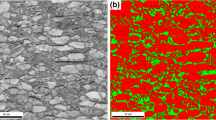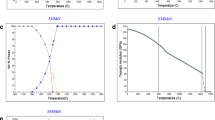Abstract
A green manufacturing and forming technology called the ultra-high temperature forging is introduced. The highest temperature of the ingot in the new forging technology was about 200 °C higher than the initial forging temperature in the traditional forging process. The DEFORM-3D software was used to simulate both the ultra-high temperature forging process and the traditional forging process. The ingot was cut longitudinally along the centreline. Nine points on the axis of the cutting plane and nine points on the radial direction were selected. The equivalent stress and the equivalent strain of these points were compared respectively under the two forging processes by using the particle tracking method. The typical points which were easy to crack under two different forging processes were found. Comparing with the tensile strength calculated by the software JMatPro® and the maximum principal stress calculated by the software DEFORM-3D, we found the new forging technology could avoid hot cracking.











Similar content being viewed by others
Availability of data and materials
The data used to support the findings of this study are included within the article.
References
Zavalishchin, A., Rumyantsev, M., Chikishev, D.: Influence of “soft” the reduction on the structure of continuous cast ingot and the properties of rolled products of micro-alloyed steels. Metallurgist 63(3), 238–248 (2019). https://doi.org/10.1007/s11015-019-00817-8
Smyrnov, Y., Belevitin, V., Skliar, V.: Application of numerical model of continuous cast bloom crystallization to improve the efficiency of mechanical soft the reduction technology. Mater. Sci. Forum 946, 684–689 (2019). https://doi.org/10.4028/www.scientific.net/MSF.946.684
Seii, N., Hakaru, N., Tetsuya, F.: Control of centerline segregation in continuously cast blooms by continuous forging process. ISLJ Int. 35(6), 673–679 (1995). https://doi.org/10.2355/isijinternational.35.673
Chen, Y., Ji, C., Zhu, M.Y.: Control model of bloom dynamic soft reduction. J. Iron. Steel Res. Int. 17(9), 31–35 (2010). https://doi.org/10.1016/S1006-706X(10)60138-0
Matt, J.K., Dewey, M.H., Bruce, A.K.: Dynamic soft reduction of continuously cast slabs. Iron Steel Technol. 5(7), 29–36 (2008)
Li, X.B., DH, Tang ZY, Tang ZY and He JC,: Formation of internal cracks during soft reduction in rectangular bloom continuous casting. Int. J. Miner. Metall. Mater. 19(1), 21–29 (2012). https://doi.org/10.1007/s12613-012-0510-9
Koc, M., Vazquez, V., Witulski, T., Altan, T.: Application of the finite element method to predict material flow and defects in the semi-solid forging of A356 aluminum alloys. J. Mater. Process. Tech. 59(1), 106–112 (1996)
Becker, E., Langlois, L., Favier, V., Bigot, R.: Thermomechanical modelling and simulation of C38 thixoextrusion steel. Solid State Phenom. 217, 130–137 (2015)
Wang, K.K.: The current situation and thinking of material processing industry in Gansu Province. In: Love Longyuan—The 15th Batch of Achievements of Doctor Service Group on Probation. Organization Department of Gansu Provincial Committee of the Communist Party of China, pp. 221–223 (2015)
Wang, K.K., Fu, W., Hu, Z.Q.: A high uniformity short process forming method for large metal components. China: ZL201711262274.8 (2017)
Zheng, Z.H., Wang, B.Y., Hu, Z.H.: Metal flow law of steel ball forming by skew rolling. J. Univ. Sci. Technol. Beijing 6, 782–788 (2015)
Guo, W., Wang, D., Lu, D.P.: Numerical simulation on cyclic closed-die forging technology. Forg. Stamp. Technol. 42(01), 149–154 (2017)
Wang, Q.X., Guo, F.W., Li, S.J.: Research on the cavity defect closure of hollow ingot. Forg. Stamp. Technol. 39(10), 9–14 (2014)
Zhang, Z.J., Dai, G.Z., Wu, S.N.: Simulation of 42CrMo steel billet upsetting and its defects analyses during forming process based on the software DEFORM-3D. Mater. Sci. Eng. 499(1), 49–52 (2009). https://doi.org/10.1016/j.msea.2007.11.135
Wang, S.Z., Sun, B.: Development of heavy plate of pre-hardened plastic die steel 718. Spec. Steel 31(5), 49–50 (2010)
Zang, X.M., Deng, X., Li, W.M.: A withdrawing new technology of electro slag remelting for die steel 718 slab ingot. J. Mater. Metall. 15, 39–42 (2016)
He, Y.L., Gao, W., Li, L.: Effect of heat treatment on machinability of 718 plastic die steel. Heat Treat. Met. 29, 20–23 (2004)
Liu, H.H.: Research on Microstructural Modification and Mechanical Properties of Pre-hardened 718H Plastic Mold Steel with Large Cross-Section. University of Science and Technology of China (2019)
Heidarzadeh, M., Keshmiri, H., Heidarzadeh, M.: Influence of mould and insulation design on soundness of tool steel ingot by numerical simulation. J. Iron Steel Res. 20(07), 78–83 (2013). https://doi.org/10.1016/S1006-706X(13)60130-2
Abootorabi, A., Korojy, B., Jabbareh, M.A.: Effect of mould design on the niyama criteria during solidification of CH3C 80t ingot. Ironmak. Steelmak. 47(07), 722–730 (2020). https://doi.org/10.1080/03019233.2019.1583879
Xu, Y.D., Wang, Y.N., Zhang, G.B., Guo, M., Wang, G., Mou, X.P., Cui, L.: Steel ingot mold’s tapper designing and validation based on solidification simulation. IOP Conf. Ser.: Earth Environ. Sci. 189, 032015 (2018). https://doi.org/10.1088/1755-1315/189/3/032015
Zong, N.F., Zhang, H., Liu, Y.: Analysis on morphology and stress concentration in continuous casting bloom to learn the formation and propagation of internal cracks induced by soft reduction technology. Contin. Cast. 46(9), 872–885 (2019). https://doi.org/10.1080/03019233.2018.1556911
Li, Y.J., Li, L., Zhang, J.Q.: Study and application of a simplified soft the reduction amount model for improved internal quality of continuous casting bloom. Steel Res. Int. 88(12), 176–185 (2017). https://doi.org/10.1002/srin.201700176
Wang, B., Zhang, J.M., Xiao, C.: Formation mechanism of internal cracks in continuous casting slabs with soft reduction. J. Univ. Sci. Technol. Beijing 38(3), 351–356 (2016)
Funding
Funding was provided by The National Key Research and Development Program of China (Grant No. 2017YFB0701803).
Author information
Authors and Affiliations
Corresponding author
Ethics declarations
Conflict of interests
The authors declare that they have no known competing financial interests or personal relationships that could have appeared to influence the work reported in this paper.
Ethical approval and consent to participate
Not applicable.
Consent to publish
That the work described has not been published before (except in the form of an abstract or as part of a published lecture, review, or thesis). That it is not under consideration for publication elsewhere; That its publication has been approved by all co-authors, if any; That its publication has been approved (tacitly or explicitly) by the responsible authorities at the institution where the work is carried out.
Additional information
Publisher's Note
Springer Nature remains neutral with regard to jurisdictional claims in published maps and institutional affiliations.
Rights and permissions
About this article
Cite this article
Wu, Yq., Wang, Kk. The ultra-high temperature forging process based on DEFORM-3D simulation. Int J Interact Des Manuf 16, 99–108 (2022). https://doi.org/10.1007/s12008-021-00811-y
Received:
Accepted:
Published:
Issue Date:
DOI: https://doi.org/10.1007/s12008-021-00811-y




